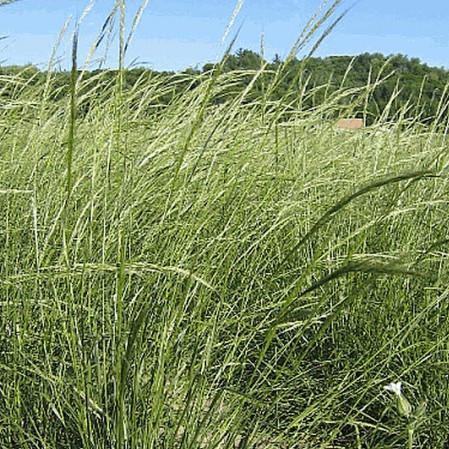Green Needle Grass Seeds
Stipa viridula
- HOW TO GROW
- FAST FACTS
HOW TO GROW
Sowing: Direct sow either in late fall or early spring. Press the seed into the surface of the soil, compacting the soil very firmly. For spring planting, mix the seeds with moist sand and store in the refrigerator for 60 days before planting. Keep the soil saturated until germination.
Growing: Water seedlings occasionally until they become established. This plant prefers dry and sandy soil, and tolerates drought extremely well. It also adapts well to various soil types such as clay, and gravel. This plant establishes itself rather slowly, but may eventually spread by self-seeding. This plant makes an very good choice for erosion control. It is also a popular ornamental plant, and the seeds attract birds and other small animals.
Seed Saving: At the end of the season, the seed heads will begin to ripen. Strip the mature seed from the stem; gloves may be necessary for protection. Spread the seed out and allow it to dry completely. Store the seed in a cool, dry place.
FAST FACTS
Latin Name: Stipa viridula
Species Origin: US Native Grass or Sedge
Type: Native Grasses, Cool Season
Life Cycle: Perennial
USDA Zones: 2, 3, 4, 5, 6, 7, 8
US Regions: California, Mountain, Arid/Desert, Plains/Texas, Midwest
Seeds per Ounce: 14,900
Stratification: Cold/Wet for 8 Weeks
Germination Ease: Stratify 8 Weeks
Sunlight: Full Sun
Height: 36 Inches
Color: Green, Brown
Bloom Season: Blooms Early Summer
DESCRIPTION

HOW TO GROW
Sowing: Direct sow either in late fall or early spring. Press the seed into the surface of the soil, compacting the soil very firmly. For spring planting, mix the seeds with moist sand and store in the refrigerator for 60 days before planting. Keep the soil saturated until germination.
Growing: Water seedlings occasionally until they become established. This plant prefers dry and sandy soil, and tolerates drought extremely well. It also adapts well to various soil types such as clay, and gravel. This plant establishes itself rather slowly, but may eventually spread by self-seeding. This plant makes an very good choice for erosion control. It is also a popular ornamental plant, and the seeds attract birds and other small animals.
Seed Saving: At the end of the season, the seed heads will begin to ripen. Strip the mature seed from the stem; gloves may be necessary for protection. Spread the seed out and allow it to dry completely. Store the seed in a cool, dry place.
FAST FACTS
Latin Name: Stipa viridula
Species Origin: US Native Grass or Sedge
Type: Native Grasses, Cool Season
Life Cycle: Perennial
USDA Zones: 2, 3, 4, 5, 6, 7, 8
US Regions: California, Mountain, Arid/Desert, Plains/Texas, Midwest
Seeds per Ounce: 14,900
Stratification: Cold/Wet for 8 Weeks
Germination Ease: Stratify 8 Weeks
Sunlight: Full Sun
Height: 36 Inches
Color: Green, Brown
Bloom Season: Blooms Early Summer



